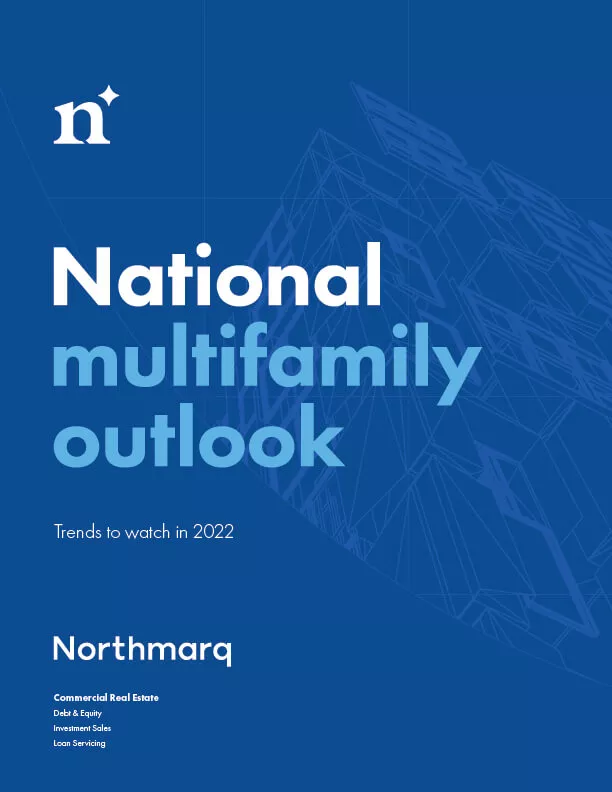National Multifamily 2022 Outlook: Sector Emerges from the Pandemic as a Standout, Boasting Relentless Demand
Report identifies demand-supply imbalance fueling staggering rent growth, tight vacancies, and robust investment opportunities.
MINNEAPOLIS, MINNESOTA (January 21, 2022) – Multifamily properties across the U.S. posted record-setting performances in 2021, with the momentum forecast to carry over into 2022, according to a special Multifamily National Outlook released by Northmarq and authored by Research Director Pete O’Neil.
Multifamily market fundamentals quickly rebounded from the pandemic, with investors attracted to the sector’s explosive rent growth, tight vacancies, spiking absorption, and strong migration trends. These dynamic improvements in property performance led to a surge in investment capital flooding into the red-hot sector. Investors are recognizing attractive yields in multifamily that may be difficult to achieve elsewhere.
The standout sector is experiencing more demand than supply, giving rental operators added pricing power. The demand-supply imbalance is driven by several factors including sticker shock from would-be homebuyers priced out of the housing market; labor shortages, supply chain deficiencies and escalating material costs postponing construction of new multifamily product; and robust migration growth.
“Our report shows that supply continues to lag demand for rental units, leading to rent increases and a continued robust appetite for investments, which we anticipate will continue in 2022,” said Trevor Koskovich, Northmarq’s President-Investment Sales.
The special report identifies five additional trends:
- The Economy - A full economic recovery is anticipated in 2022, which should continue to drive strong demand for rental units. Some uncertainty surrounding the Delta and Omicron variants, however, could disrupt economic growth, at least in the short term.
- Rent Trends - Healthy rent gains are likely to continue in 2022 but will not be a repeat of the double-digit gains throughout much of the country in 2021.
- Investment Market - As rents have soared, so have property sales. Nationally, investment volume jumped approximately 70 percent from 2020 levels and more than 40 percent from previous peaks. Investors around the globe have increased allocations to multifamily housing. Vigorous investor competition should continue to push pricing higher as cap rates compress.
- Financing Climate - Multifamily’s lending market remains robust, which is expected to continue in 2022. Increases in multifamily originations will likely start with Freddie Mac and Fannie Mae, which each have caps of $78 billion this year. Even concerns around rising interest rates, inflation and increasing construction costs are not lessening outlooks. “There is continued liquidity and likely spread compression due to lender demand,” said Jeff Erxleben, Northmarq’s Executive Vice President/Executive Managing Director. “I don’t see a slowdown in the momentum in the lending market at all.”
Additionally, the number of bridge loans spiked in 2021, particularly for value-add acquisitions, which were increasingly popular due to the rapid rent growth. “We saw clients across the country acquire value-add properties where they were looking to make improvements for renters and also increase the value of the property,” says Erxleben. “In our experience, bridge lending was off the charts in 2021, and we expect it to remain prevalent throughout 2022.”Looking ahead to this year, the cost of capital is likely the greatest uncertainty in the capital markets, however, volume is expected to remain strong. - Single-Family Build-to-Rent - Changing renter demographics are driving unprecedented growth in the single-family build-to-rent (SF BTR) sector, emerging as an alternative to traditional apartments. Developers are ramping up activity on thousands of new units, particularly in the high-growth Southern U.S. markets. Dozens of projects totaling more than $1.5 billion sold in 2021. Meanwhile, billions of dollars of debt and equity capital continue to move into this increasingly attractive investment class.
Conditions for multifamily look to remain favorable in 2022, building on the substantial strengthening in 2021. Demand for units should be buoyed by additional recovery in the labor market, particularly in some of the country’s dense urban areas where post-COVID reopening measures took longer to take hold. The pace of development is likely to accelerate, but most major markets are expected to remain undersupplied throughout 2022, keeping vacancy rates near cyclical lows. These tight conditions will allow room for additional rent increases, but the pace of gains should trail the spikes recorded in 2021. While a few potential challenges lie ahead, it is hard to overstate the current health of the multifamily market.
Insights
Research to help you make knowledgeable investment decisions
